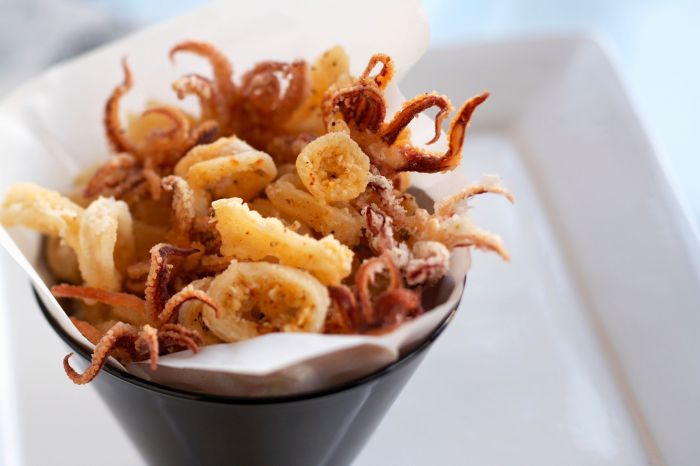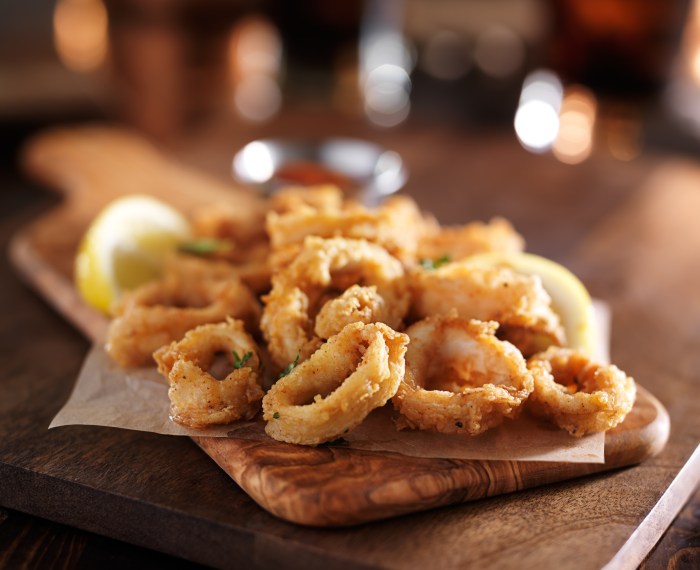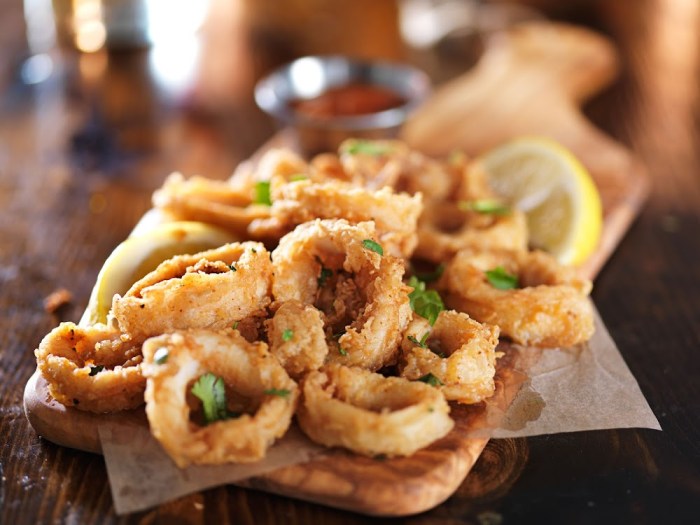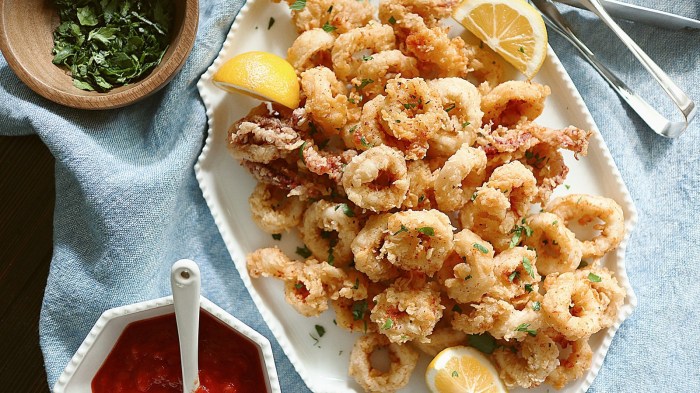Grapes is to wine as squid is to calamari, a culinary transformation that captivates taste buds and ignites culinary creativity. From the vineyards to the ocean’s depths, these two distinct ingredients embark on a parallel journey, each culminating in a delectable delicacy that tantalizes the palate and enriches culinary traditions.
Wine, crafted from the fermented juice of grapes, boasts a rich history and diverse flavor profile. Squid, a versatile seafood, offers a unique texture and delicate flavor, making it a culinary chameleon that adapts effortlessly to various cuisines.
Grapes and Wine Production

Winemaking is an ancient and complex process that transforms grapes into one of the world’s most beloved beverages. The journey from grape cultivation to bottling involves meticulous care and a deep understanding of the intricate relationship between the fruit, the soil, and the climate.
Grape Cultivation
The foundation of winemaking lies in the cultivation of grapes. Winemakers carefully select grape varieties that are well-suited to the specific terroir, a term that encompasses the unique combination of soil, climate, and topography of a particular vineyard.
Grapevines require ample sunlight, well-drained soil, and a moderate climate. Viticulturists, experts in grape cultivation, employ various techniques to optimize vine health and grape quality, including pruning, irrigation, and pest management.
Harvesting
The timing of the grape harvest is crucial and varies depending on the grape variety, climate, and desired wine style. Grapes are typically harvested when they reach optimal ripeness, a stage determined by factors such as sugar content, acidity, and flavor profile.
Harvesting methods range from manual picking, where grapes are carefully hand-selected, to mechanical harvesting, which involves using machines to shake the vines and collect the grapes. Each method has its advantages and disadvantages, with manual harvesting offering greater selectivity and quality control.
Crushing and Fermentation
After harvesting, the grapes are crushed to release their juice, known as must. The must is then transferred to fermentation vessels, typically stainless steel tanks or oak barrels. Yeast is added to the must, which converts the sugars in the grape juice into alcohol and carbon dioxide through the process of fermentation.
The type of yeast used, the fermentation temperature, and the duration of fermentation all influence the wine’s flavor, aroma, and texture.
Aging and Maturation
Following fermentation, the wine undergoes a period of aging and maturation. This process can take place in stainless steel tanks, oak barrels, or a combination of both. During aging, the wine develops complexity and depth as it interacts with the wood and undergoes various chemical reactions.
The length of aging varies depending on the wine style and desired characteristics. Some wines are aged for a few months, while others may spend years or even decades in barrels.
Bottling
Once the wine has reached its desired maturity, it is bottled and prepared for distribution. Bottling involves filtering the wine to remove any sediment and adding sulfur dioxide as a preservative. The bottles are then sealed with corks or screw caps and labeled with information about the wine, including the grape variety, vintage, and producer.
Factors Influencing Wine Taste and Quality
The taste and quality of wine are influenced by a myriad of factors, including:
- Grape variety: Different grape varieties impart unique flavor profiles and characteristics to the wine.
- Terroir: The soil, climate, and topography of the vineyard influence the grape’s growth and ultimately the wine’s taste.
- Winemaking techniques: The methods used in grape cultivation, harvesting, fermentation, and aging all contribute to the wine’s final character.
- Vintage: The weather conditions during the growing season can significantly impact the quality and style of the wine.
Squid and Seafood Processing

Squid, a type of cephalopod, is a versatile seafood delicacy enjoyed worldwide. Its unique taste and texture make it a popular ingredient in various cuisines. Processing squid for consumption involves several steps, from catching to cleaning and preparing.
Catching Squid
Squid are typically caught using fishing nets or traps. Commercial fishing vessels employ large-scale nets to capture large quantities of squid. Smaller-scale fisheries may use hand-held jigs or traps to target specific squid species.
Cleaning and Preparing Squid
Once caught, squid must be cleaned and prepared for consumption. The cleaning process involves removing the head, viscera, and ink sac. The mantle (body) is then scored and skinned to remove the outer layer. The cleaned squid is then cut into various shapes and sizes depending on the intended use.
Squid Species for Culinary Purposes
Several squid species are commonly used for culinary purposes. These include:
- Giant squid (Architeuthis dux) : The largest squid species, known for its massive size and impressive tentacles.
- Colossal squid (Mesonychoteuthis hamiltoni) : A deep-sea squid species with a long, cylindrical body and large fins.
- Japanese flying squid (Todarodes pacificus) : A common commercial squid species with a torpedo-shaped body and large eyes.
- European squid (Loligo vulgaris) : A smaller squid species with a short, stocky body and rounded fins.
- Arrow squid (Nototodarus gouldi) : A fast-swimming squid species with a streamlined body and pointed fins.
Factors Influencing Taste and Texture
The taste and texture of squid can vary depending on several factors:
- Species: Different squid species have unique flavors and textures.
- Size: Larger squid tend to have a firmer texture and more pronounced flavor.
- Age: Younger squid are generally more tender and have a milder flavor.
- Cooking method: The cooking method can significantly impact the texture and flavor of squid.
- Storage conditions: Improper storage can affect the freshness and quality of squid.
Culinary Uses of Grapes and Squid

Grapes and squid, though seemingly disparate ingredients, offer a surprising culinary synergy. Grapes lend their natural sweetness and subtle acidity to dishes, while squid provides a tender and slightly chewy texture. Together, they create a harmonious balance of flavors and textures that can elevate any dish.
One classic example of this combination is the Italian dish Insalata di polpo e uva(octopus and grape salad). This salad features tender boiled octopus tossed with halved grapes, red onions, and a simple vinaigrette. The grapes add a burst of sweetness that complements the savory octopus, while the red onions provide a sharp contrast.
Another popular dish is Paella de marisco con uvas(seafood paella with grapes). In this dish, grapes are added to the traditional paella mixture of rice, seafood, and vegetables. The grapes add a touch of sweetness and a vibrant color to the paella, enhancing its overall flavor profile.
Creative Culinary Preparations
Beyond these traditional dishes, grapes and squid can be used in various creative culinary preparations. For example, grilled squid can be paired with a sweet and tangy grape salsa, made with chopped grapes, red onions, cilantro, and lime juice. Alternatively, grapes can be roasted and added to a squid ink risotto, infusing the dish with a subtle sweetness and a beautiful purple hue.
Nutritional Comparison of Grapes and Squid

Grapes and squid are both nutritious foods that offer a variety of health benefits. Grapes are a good source of vitamins, minerals, and antioxidants, while squid is a good source of protein, omega-3 fatty acids, and iodine.The following table compares the nutritional content of grapes and squid per 100 grams:| Nutrient | Grapes | Squid ||—|—|—|| Calories | 69 | 75 || Protein | 0.7 grams | 18 grams || Carbohydrates | 18 grams | 2 grams || Fat | 0.2 grams | 1 gram || Fiber | 1 gram | 0 grams || Vitamin C | 10 milligrams | 0 milligrams || Potassium | 181 milligrams | 284 milligrams || Iron | 0.4 milligrams | 1.2 milligrams || Calcium | 10 milligrams | 52 milligrams |As you can see, grapes and squid have different nutritional profiles.
Grapes are a good source of carbohydrates, vitamins, and minerals, while squid is a good source of protein, omega-3 fatty acids, and iodine. Both foods can be included in a healthy diet.
Health Benefits of Grapes
Grapes are a good source of antioxidants, which can help protect the body from damage caused by free radicals. Free radicals are unstable molecules that can damage cells and DNA, and they have been linked to a number of chronic diseases, including cancer and heart disease.The
antioxidants in grapes have been shown to have a number of health benefits, including:* Reducing the risk of heart disease
- Lowering blood pressure
- Improving cholesterol levels
- Boosting the immune system
- Protecting against cancer
Health Benefits of Squid
Squid is a good source of protein, omega-3 fatty acids, and iodine. Protein is essential for building and repairing tissues, and it is also important for maintaining a healthy immune system. Omega-3 fatty acids are essential fatty acids that the body cannot produce on its own.
They have a number of health benefits, including:* Reducing the risk of heart disease
- Lowering blood pressure
- Improving cholesterol levels
- Reducing inflammation
- Boosting brain function
Iodine is an essential mineral that is necessary for the production of thyroid hormones. Thyroid hormones regulate a number of important bodily functions, including metabolism, growth, and development.
Cultural Significance of Grapes and Squid

Grapes and squid have played significant cultural roles throughout history, holding symbolic and practical value in various regions. Grapes, with their sweet taste and versatile uses, have been a staple in winemaking, religious ceremonies, and cultural traditions. Squid, known for its unique texture and culinary versatility, has been an integral part of coastal cuisines and maritime cultures.
Grapes in Cultural Traditions, Grapes is to wine as squid is to
- In ancient Greece, grapes were sacred to the god Dionysus and symbolized fertility, abundance, and joy. Wine made from grapes was used in religious rituals and celebrations.
- In Christianity, grapes represent the blood of Christ and are used in the sacrament of Holy Communion. They symbolize sacrifice, redemption, and eternal life.
- In many cultures, grapes are associated with prosperity and good fortune. In China, the grapevine is considered a symbol of longevity and abundance.
Squid in Culinary Traditions
- In Japan, squid is a popular ingredient in sushi, sashimi, and tempura. It is also used in soups, stews, and stir-fries.
- In Mediterranean cuisine, squid is often grilled, fried, or stuffed with rice and vegetables. It is a staple in dishes such as paella and bouillabaisse.
- In Southeast Asia, squid is commonly used in curries, salads, and street food dishes. It is known for its chewy texture and unique flavor.
Anecdotes and Stories
A famous anecdote about grapes involves the Roman emperor Augustus, who is said to have been cured of a fever by eating grapes. This event led to grapes becoming a symbol of health and vitality in Roman culture.
In Japan, there is a legend about a giant squid that attacked a fishing boat. The squid was so large that it wrapped its tentacles around the boat and pulled it underwater. The story has been passed down for generations and has become a symbol of the dangers of the sea.
Frequently Asked Questions: Grapes Is To Wine As Squid Is To
What are the key factors that influence the taste of wine?
Grape variety, climate, soil conditions, and winemaking techniques all play crucial roles in shaping the flavor profile of wine.
How is squid typically prepared for consumption?
Squid can be cleaned, cut, and cooked in various ways, including grilling, frying, steaming, and boiling.
What are the health benefits of consuming grapes?
Grapes are rich in antioxidants, vitamins, and minerals, which may offer potential health benefits such as reduced risk of heart disease and improved cognitive function.
